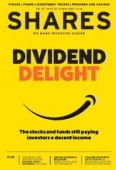Archived article
Please note that tax, investment, pension and ISA rules can change and the information and any views contained in this article may now be inaccurate.
Why don’t stop losses always work?

Could you explain why stop losses don’t always work? I’ve recently had the experience of setting a stop loss only to see when I logged back a day or so later that the price had fallen through the trigger price and the bottom price and the holding had not been sold.
Keith Butler
Reporter Yoosof Farah replies:
When you make an investment, it’s all about hope. But when you sell an investment, it’s often about fear – fear about potentially forgoing further profits or fear that any existing losses could get worse.
One way to overcome those fears is using a stop loss order. This is a way of telling your investment platform provider that you want to get out of a stock if falls to a certain price or below. Investors use them as a sort of safety net to minimise losses.
HOW DO THEY WORK?
For readers who aren’t familiar with stop losses, it’s worth running through an example. Let’s say you buy a stock at 100p and you decide that you don’t want to keep it if it falls by 20% or more – so you would set your stop loss at 80p in this case.
Should your stop loss be triggered, an alert is sent to your investment platform provider to sell the shares at the best possible price.
As with the sale of any asset, a buyer is required. If the shares are in freefall on the back of a profit warning, for example, it can be difficult to find a buyer at the stop loss price, potentially leaving investors with a larger than anticipated loss. This is known as slippage.
In addition, it cannot be guaranteed that a stop loss order will be executed, for example in situations beyond an investment platform’s control, or where market conditions happen to be particularly volatile.
STOP LOSS BENEFITS
There are merits to having stop losses in place. They can offer you a form of protection when the market falls, and also help take the emotion out of investing, which is useful if you are a risk-averse investor and/or more concerned about large losses. But on the flip side it does also mean you could miss out on gains if the stock recovers shortly afterwards.
A 2009 study by researchers at Lund University in Sweden comparing stop losses to a buy and hold strategy, using data from analysing the Swedish stock market, found that all stop losses – from 5% up to 55% – worked better than a buy and hold strategy.
TRAILING STOP LOSSES
As long as investors stay disciplined and aren’t tempted to move their stop losses, it also found that trailing stop losses worked better. These work differently by simultaneously trying to help protect profit and limit losses.
Instead of setting a single point at which to exit a trade, if the shares go higher the trailing stop will move upwards with it.
For example, someone could buy a stock at £40 and have a trailing stop loss of 20% which would be £32. If the share price rises to £60 then the trailing stop becomes 20% of that higher price which is £48.
WHEN STOP LOSSES GO WRONG
It’s important to know, as mentioned above, that there are instances when stop losses might not be executed. In fact, it’s a fairly common situation.
Say you hold shares in Company X and the current price is 400p. You decide to set a stop loss with a trigger level of 350p and a bottom price of 325p. That means if the price drops to 350p your platform provider will try and sell your shares, but only if they can get 325p or higher.
The main thing that could stop the order triggering is especially bad news between market sessions. So if the price closes at 400p, but the next morning Company X issues a trading update for example
that says profits will be way less than expected, the price could open significantly lower than 400p.
If it opens lower than 325p then the platform provider won’t be able to execute the stop loss because you’ve set a bottom price of 325p and that price is not achievable.
You can set a stop loss without a bottom price, but then you have zero protection on your order, so even if the price opened at 150p the next day, and you had a trigger of 350p but no bottom price, the provider would sell your holding at or around 150p.
Similarly, if the price drops especially quickly during a market session rather than overnight, typically due to severe company or economic news being released throughout the day, then it may drop too fast for your order to be executed.
SOME STOCKS ARE ILLIQUID
Another scenario is liquidity which is how easily you can trade a stock. If the stock you have a stop loss on is illiquid, then your provider may only be able to sell some of your holding if the price drops to your trigger. You may be left with a holding you don’t want, that you can’t sell in its entirely, and with the price dropping.
It may then drop below your bottom price, or even if it doesn’t and there are liquidity issues, you could end up holding the stock even if the price is there.
DO YOU HAVE ANY QUESTIONS ABOUT MARKETS AND INVESTING?
Let us know if we can help explain how something works or any other question relating to markets and investing. We’ll do our best to answer your question in a future edition of Shares.
Email editorial@sharesmagazine.co.uk with ‘Reader question’ in the subject line.
Please note, we only provide information and we do not provide financial advice. We cannot comment on individual stocks, bonds, investment trusts, ETFs or funds. If you’re unsure please consult a suitably qualified financial adviser.
Important information:
These articles are provided by Shares magazine which is published by AJ Bell Media, a part of AJ Bell. Shares is not written by AJ Bell.
Shares is provided for your general information and use and is not a personal recommendation to invest. It is not intended to be relied upon by you in making or not making any investment decisions. The investments referred to in these articles will not be suitable for all investors. If in doubt please seek appropriate independent financial advice.
Investors acting on the information in these articles do so at their own risk and AJ Bell Media and its staff do not accept liability for losses suffered by investors as a result of their investment decisions.

 magazine
magazine








